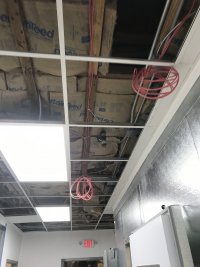-
Welcome to The Building Code Forum
Your premier resource for building code knowledge.
This forum remains free to the public thanks to the generous support of our Sawhorse Members and Corporate Sponsors. Their contributions help keep this community thriving and accessible.
Want enhanced access to expert discussions and exclusive features? Learn more about the benefits here.
Ready to upgrade? Log in and upgrade now.
You are using an out of date browser. It may not display this or other websites correctly.
You should upgrade or use an alternative browser.
You should upgrade or use an alternative browser.
Code Picture 31 Aug 2018 - Would you pass this?
- Thread starter jar546
- Start date
fatboy
Administrator
Not fully in contact/enclosed within a cavity.
jar546
CBO
Not fully in contact/enclosed within a cavity.
Not sure I understand. I am looking at something more specific about this installation.
Francis Vineyard
REGISTERED
From what I can detect from my tiny Android screen the insulaion paper facing is not in substantial contact with the back side of an approved finished surface.
Unfortunately I see this often which means neighboring localities are ignoring or are ignorant of the requirement.
Unfortunately I see this often which means neighboring localities are ignoring or are ignorant of the requirement.
Francis Vineyard
REGISTERED
Also if that is the issue, covering it with foil scrim on the walls is not an approved surface in accordance with the manufacturer's guidelines.
From what I can detect from my tiny Android screen the insulaion paper facing is not in substantial contact with the back side of an approved finished surface.
Unfortunately I see this often which means neighboring localities are ignoring or are ignorant of the requirement.
because of FSI/SDI?
jar546
CBO
When batt insulation is installed above suspended ceilings, the installations should conform to the fire-safety requirements of the prevailing building code. In many commercial jobs, however, code officials approve insulation applications that do not conform to the prevailing building code.
The Insulation Contractors Association of America’s Technical Bulletin 27: Applying Batt Insulation Above Suspended Ceilings to Meet Code addresses and recommends practices known to conform to the requirements of the International Building Code and to all three model building codes.
All requirements for exposed applications of insulation for the model building codes are similar and agree to the following conditions:
The Insulation Contractors Association of America’s Technical Bulletin 27: Applying Batt Insulation Above Suspended Ceilings to Meet Code addresses and recommends practices known to conform to the requirements of the International Building Code and to all three model building codes.
All requirements for exposed applications of insulation for the model building codes are similar and agree to the following conditions:
- Insulation, including facing, shall have a Flame Spread Index = 25 or less and a Smoke Developed Index = 450 or less when tested per ASTM E-84 or UL 723. Standard foil-faced and kraft-faced batts do not conform to the requirements of any model code for exposed applications; their facings have Flame Spread Indices greater than 25.
- The only acceptable application of standard foil-faced and kraft-faced batts is when the product shall be behind, and in substantial contact with, an approved ceiling construction material as required by the building codes. Substantial contact means that most of the facing surface of the insulation touches the approved ceiling construction material. Neither inset nor face stapling excludes the substantial contact requirement. If substantial contact is not maintained and an open plenum results between the installed batt insulation and an approved non-combustible ceiling construction material, then an exposed application results. In this case the proper vapor retarder facing material shall have a flame spread index of 25 or less; i.e., FSK (Foil Scrim Kraft) and/or FSP (Foil Scrim Poly).
- A flame spread rated facing installed over kraft, standard foil or other non-rated facing does not meet code.
jar546
CBO
Right on the paper-faced insulation:
"vapor retarder is flammable and should not be left exposed"
Looks like a plenum to me on top of all that...........
The smoke and flame index is not rated for that use.
"vapor retarder is flammable and should not be left exposed"
Looks like a plenum to me on top of all that...........
The smoke and flame index is not rated for that use.
Give it enough time and much of it it will be laying on the t-bar.
RJJ
Co-Founder
I agree! Paper face cannot be there, poor installation and sure looks like a plenum to me.
fatboy
Administrator
Not sure I understand. I am looking at something more specific about this installation.
- The only acceptable application of standard foil-faced and kraft-faced batts is when the product shall be behind, and in substantial contact with, an approved ceiling construction material as required by the building codes. Substantial contact means that most of the facing surface of the insulation touches the approved ceiling construction material.
Mr. Inspector
SAWHORSE
I see this a lot for tenant fit-outs. But I can't say anything because they usually the insulation is existing and they are only replacing the suspended ceiling. Also the romex is existing.

